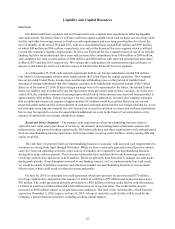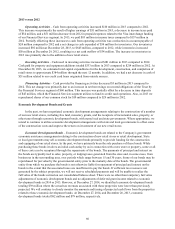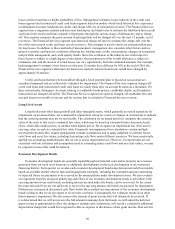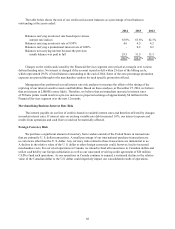Cabela's 2014 Annual Report Download - page 70
Download and view the complete annual report
Please find page 70 of the 2014 Cabela's annual report below. You can navigate through the pages in the report by either clicking on the pages listed below, or by using the keyword search tool below to find specific information within the annual report.60
2013 versus 2012
Operating Activities – Cash from operating activities increased $110 million in 2013 compared to 2012.
This increase was primarily the result of higher earnings of $51 million in 2013, a decrease in income taxes paid
of $54 million, and a $51 million decrease from 2012 in prepaid expenses related to the Visa interchange funding
of our Financial Services segment. In 2013, we paid $83 million in income taxes compared to $137 million in
2012. Partially offsetting these increases to cash from operating activities was a reduction in accounts payable of
$24 million compared to 2012 and a net change in cash expended of $34 million for inventories. Our inventories
increased $92 million at December 28, 2013, to $645 million, compared to 2012, while inventories increased
$58 million at December 29, 2012, resulting in a net cash outflow of $34 million. The increase in inventories in
2013 was primarily due to the addition of new retail stores.
Investing Activities – Cash used in investing activities increased $181 million in 2013 compared to 2012.
Cash paid for property and equipment additions totaled $333 million in 2013 compared to $214 million in 2012. At
December 28, 2013, we estimated total capital expenditures for the development, construction, and completion of
retail stores to approximate $384 million through the next 12 months. In addition, we had a net decrease in cash of
$51 million related to our credit card loans originated from outside sources.
Financing Activities – Cash provided by financing activities decreased $3 million in 2013 compared to
2012. This net change was primarily due to an increase in net borrowings on secured obligations of the Trust by
the Financial Services segment of $60 million. This increase was partially offset by a decrease in time deposits
of $45 million, which the Financial Services segment utilizes to fund its credit card operations. Also, in 2013 we
repurchased shares of our common stock for $10 million compared to $29 million in 2012.
Economic Development Bonds and Grants
In the past, we have negotiated economic development arrangements relating to the construction of a number
of our new retail stores, including free land, monetary grants, and the recapture of incremental sales, property, or
other taxes through economic development bonds, with many local and state governments. Where appropriate, we
intend to continue to utilize economic development arrangements with state and local governments to offset some
of the construction costs and improve the return on investment of our new retail stores.
Economic Development Bonds – Economic development bonds are related to the Company’s government
economic assistance arrangements relating to the construction of new retail stores or retail development. State
or local governments may sell economic development bonds primarily to provide funding for the construction
and equipping of our retail stores. In the past, we have primarily been the sole purchaser of these bonds. While
purchasing these bonds involves an initial cash outlay by us in connection with a new store or property, some or all
of these costs can be recaptured through the repayments of the bonds. The payments of principal and interest on
the bonds are typically tied to sales, property, or lodging taxes generated from the store and, in some cases, from
businesses in the surrounding area, over periods which range between 15 and 30 years. Some of our bonds may be
repurchased for par value by the governmental entity prior to the maturity date of the bonds. The governmental
entity from which we purchase the bonds is not otherwise liable for repayment of principal and interest on the
bonds to the extent that the associated taxes are insufficient to pay the bonds. If sufficient tax revenue is not
generated by the subject properties, we will not receive scheduled payments and will be unable to realize the
full value of the bonds carried on our consolidated balance sheet. There were no other than temporary fair value
adjustments of economic development bonds and no adjustments of deferred grant income related to economic
development bonds in 2014 or 2013. However, at December 27, 2014, we identified economic development bonds
totaling $39 million where the actual tax revenues associated with these properties were lower than previously
projected. We will continue to closely monitor the amounts and timing of projected cash flows from the properties
related to these economic development bonds. At December 27, 2014, and December 28, 2013, economic
development bonds totaled $82 million and $79 million, respectively.
























